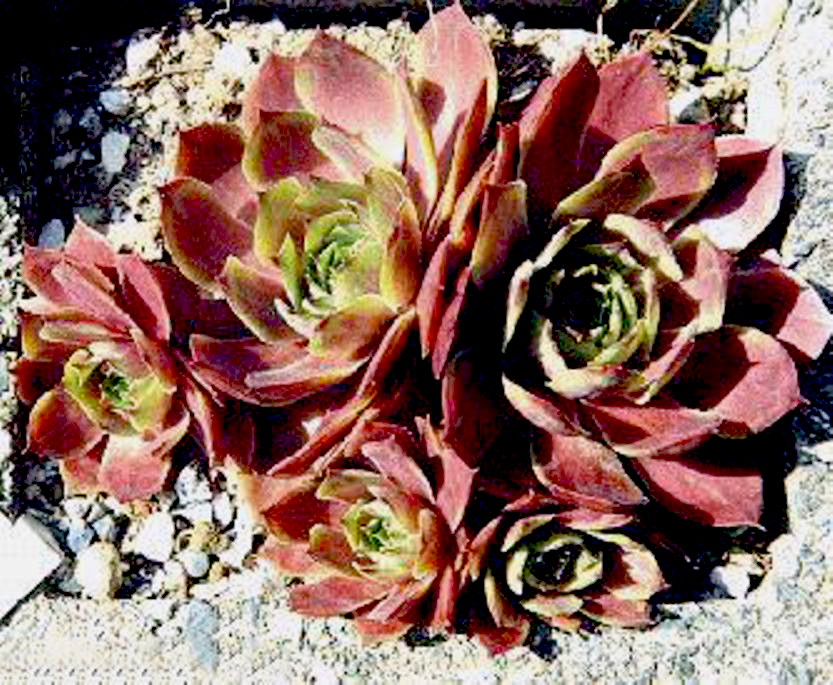By Shirley Strong (June 2001)
Strong’s Alpine Succulents
Parks, Arizona
![]()
Featured image above: An AI text-to-image impression of Semperviviums.

(This article appeared in THE AMATEURS’ DIGEST Vol 9 Issue 4 November 1997)
Nearly everybody’s grandma grew Hen and Chicks in her garden. She could enjoy these reliable succulents with minimum time spent on their care. Each year the central, fleshy rosette would surround itself with little duplicate plants, hence Hen and Chicks. Grandma could pluck up a few chicks and nestle them in a nook, cranny or bare spot to start a whole new colony of the adaptable little plants.
Correctly labelled Sempervivum, one may also hear the literal translation: Live-for-Ever. Regardless of the moniker, these plants are regaining popularity with today’s gardener and are available in ever increasing varieties of size, color and leaf texture.
From tiny one-eighth inch sempervivums which colonize into small mounds, to saucer-size plants whose offspring necessarily reach a little farther afield, they all increase by axillary stolons. The newly produced plant will root itself while still attached to the parent. Indeed the easiest way to propagate new plants is to merely wait for the chicks to take root then snip the stolons and transplant.
Within the forty species and hundreds of hybrids, there is a rainbow of color variations and blends. There are pastel pinks and lavenders, lovely bronzes, reds, purples and burgundies, as well as various shades of green to silver blues and grays.
Although all sempervivums develop in the same central rosette pattern, there are many variations of leaf texture, covering and arrangement. The fleshy leaves may be pointed, rounded, squared off, linear or even quill. Surfaces range from smooth to downy while some have fringed edges and/or tufted tips. The arachnoideum varieties have an arrangement of hairs which form perfect cobweb patterns in the center of the rosette. Leaf arrangements may be spiral or star-shaped, wide open or globose.
Perhaps the best news of all to the alpine gardener is the hardiness of these plants. Because of their origins in the high regions of Europe, Turkey, Iran, Morocco, the Balkans and the Caucasus Mountains, they adapt beautifully to the cold, arid Arizona high country. They are at home tucked into crevices in walls and rock gardens, can be grown in hollow logs, driftwood and strawberry pots or hung in moss-lined wire baskets where the chicks can spill over and attach to the sides.
The main rule for growing healthy sempervivums is adequate drainage. Some humus mixed into loose, gravely soil with a bit of bone meal added will make a good growing medium. They may be fed with a weak solution of general purpose fertilizer in the spring. During the growing season, they like a weekly supplemental watering if there is no rain. If grown in porous containers, semps may require more frequent watering during the dry springtime, so long as the drainage is good.
Semps are monocarpic, meaning they will bloom and set seed only once. A single rosette will usually flower at about three years of age after which it will wither and die. By that time. numerous rosettes will have been produced with which to replace the original.
When the winter becomes very cold, the older leaves will dry and curl up around the plants for protection. At the first hint of spring, the plants will open up and array themselves in splendid color. The coldest, snowiest winters often produce the most vivid spring colors. Some will hold their color till winter, others will green-up near the end of summer.
While immune to most pests, these plants are sometimes bothered by aphids. This is usually confined to the flower stalk. In humid areas, mealy bugs may attack. Sempervivums are members of Family Crassulaceae and as such cannot tolerate Malathion. Soapy water will usually discourage aphids. Mealies may require a systemic insecticide such as Orthene.
In the cooler areas, sempervivums can be grown in full sun to semi-shade. Where the summer sun is hotter, they prefer protection from the midday rays. Variation in the appearance of exact clones can occur due to differences in location, soil and moisture even within the same garden. This is indeed one of the many charms which fascinated Grandma and still endears Hen and Chicks to today’s fanciers.
© Copyright THE AMATEURS’ DIGEST
Rescued from The Wayback Machine.
![]()

